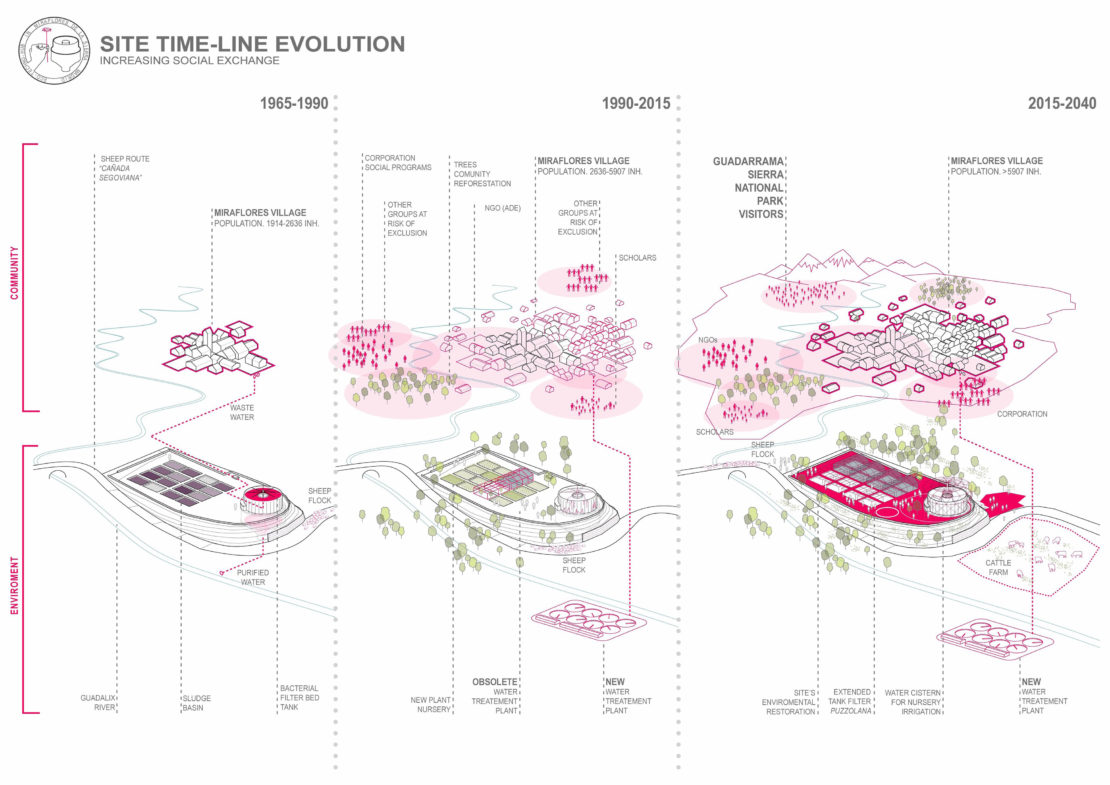Eco Techno Hub
Diego García-Setién + Silvia Sánchez


Placing architecture in its ecological framework, reveals the
various networks to which it belongs and retrieves a more complete
cultural dimension, becoming a quasi-object, an hybrid inhabitant
of the Ecosphere.
The old sewage treatment plant (1965) is now a nature reserve
located within the protected space of the sheep track and the
Guadalix River basin. The construction of a new treatment plant
after the population’s growth in the 80s turned this plant
obsolete, and since the 90s it works as a nursery for the regional
government reforestation plans. This place is also used for
environmental education activities for public and private
entities. Its demolition was discarded for both economic and
ecological reasons, since rehabilitating saves resources and
extending its life, reduces its ecological footprint.
Eco TechnoHub is a phase of inevitable entropic continuous
transformation process to which every human work is subject; it
celebrates this transformation and gets incorporated into it,
recognizing itself as an active part. From a renewed awareness and
an inclusive attitude, architecture is conceived beyond its
disciplinary autonomy to produce an artifact sensitive to its
environmental impact.
EcoTechnoHub is a prototype that shows the advantages of creative
reuse (Upcycling) of the built environment, making it useful,
educational and accessible to the public. It strengthens and
enhances the ecological and educational agenda of the current
nursery, implementing simple operations that place value on this
infrastructure, formed by the ‘bacterial filter bed’ tank and the
underground deposit.
The proposal results from emptying the infrastructure and
inserting new components, revealing and conditioning spaces
designed not to be inhabited.
[OUT]: Emptying the tank reveals an air-and-natural-light-filled
space. The filtering volcanic gravel is spread across the site as
a pavement. Emptying the underground deposit reveals a dark, deep
and compartmentalized space, suitable for exhibitions and
projections. Sludge is used as fertilizaer and water for
irrigation.
[IN]: A light umbrella-shaped structure is inserted with 2
tensioned membranes, solidary with the bicycle-wheel roof. A
network of cables ties the roof to the tank’s perimeter, serving
as its ballast and providing support for climbing plants. The mast
supports the roof and concentrates the technology for harnessing
renewable energy (geothermal, wind, sun) required to operate the
Hub. It also supports the spiral stair communicating the
underground with the lookout point; a tunnel of concrete rings is
inserted to provide access to the subterranean deposit and to a
new gridded floor, on which visitors will be suspended to
experience its depth. The new access provides flexibility of use
and management, allowing schedules and activities.
EcoTechnoHub is self-sufficient and didactic: it consumes less
power than it generates, and makes use of it as part of its
environmental education program. It is a place where communities
and ecosystems will be related, assembling neighbors and visitors
to the National Park, sheep flocks and new forests born in the
nursery. It is a support for life and promoter of biodiversity.
EcoTecnoHub is the result of ReAssembling –as a means for
architectural invention- an existing infrastructure and a new
light structure, obsolete and current technologies, inert and
living matter.
EcoTecnoHub integrates infrastructure and architecture,
communities and ecosystem, landscape and peasantry.
Credits
EcoTechnoHub: ReAssembling and Upcycling of an obsolete urban infrastructure
Authors:
Diego García-Setién + Silvia Sánchez
Team:
Gonzalo Used, Ignacio Prieto, Diego Acón, Estrella Juárez, Alfonso
Sáenz; Engineeering: Calter Ingeniería (Juan C. Arroyo, Carlos
Ríos, Elia Mª Pérez) y Buró de Textiles (Javier Tejera y Marian
Marco); Energy: Isofoton (Ramiro Caballero), Uptive (Álvaro
Ibáñez), Dhara (Daniel Cotillas), Salher (Borja Sánchez), FCC
(Santiago Morales), CESPA (Ignacio Archilla), Canal YII (Valverde
Agüí)
2016
